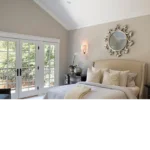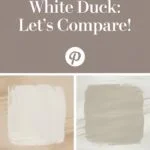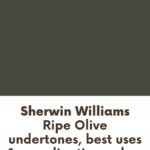In search of the ideal light sage green paint color?
This guide aims to assist you in selecting the perfect light sage green hue to spark your inspiration.
While many individuals prefer neutral wall colors, I find immense appeal in injecting a splash of color into living spaces.
Among the various wall color options, blue and green stand out as my absolute favorites.
The current trend prominently features green, a color that exudes a sense of returning to nature.

Pro Grade Paint Roller Kit, Brush & Roller for Professionals & Homeowners
Perfect for smooth finishes on your interior walls. Ideal for home improvement enthusiasts!
Buy Now on AmazonIts earthy and calming qualities contribute to a relaxing atmosphere, making it a popular choice for wall colors. Picture green wall paint, green cabinets, or even a striking green accent wall to elevate your space.
Sage green paint, in particular, is experiencing a surge in popularity, with the sage green bedroom aesthetic garnering significant attention. However, choosing the right green paint color can be a challenging task, given the multitude of available shades. Light sage green, nevertheless, stands out as a versatile and appealing option for wall paint.
- How do I choose the right shade of green paint?
- What about A warm green?
- Is sage green and mint green the same?
- What color goes good with sage green?
- Is green a suitable color choice for your house?
- Where should I use green paint?
- What is the color psychology of green?
- Top Sage Green Paint Colors

How do I choose the right shade of green paint?
Selecting the appropriate shade of green paint involves establishing the desired vibe, whether it be light green, dark green, sage green, or others. Seeking inspiration from photos and utilizing samples to test colors in your actual space, on multiple walls, and at various times of the day, can aid in the decision-making process. For an in-depth understanding of the selection process, My Paint Color Formula provides a comprehensive guide.
What about A warm green?
Inquiring about warm green tones is crucial, as warm greens typically incorporate yellow or brown hues. Olive green serves as an excellent example of a warm-toned green.

Rust-Oleum 367605 Home Interior Floor Coating Kit, Semi-Gloss Black
Ideal for updating outdated flooring at a fraction of the cost of replacement and adheres without stripping, sanding or priming.
Buy Now on AmazonSage green, on the other hand, is defined by its green-gray composition, reminiscent of dried sage leaves with a subtle silver undertone.
Is sage green and mint green the same?
Distinguishing between sage green and mint green is essential, as although these colors share similarities, mint green tends to be brighter with more prominent blue undertones, while sage green adopts a more subdued appearance due to its gray undertones.
What color goes good with sage green?
When considering color pairings, sage green complements a range of hues, including white, gray, natural wood tones, neutral browns (without excessive red undertones), blues that are either lighter or darker than sage green, deep dark green, and vibrant options like red, pink, coral, or mustard yellow to add a pop of color to your space.
Is green a suitable color choice for your house?
Absolutely! Green proves to be an excellent option for painting your house, especially for exteriors situated in green, wooded areas, imparting a nature-inspired aesthetic that enhances the overall appeal of the home.
I particularly adore green for creating nature-inspired or boho-style rooms, as it contributes to a cozy and inviting atmosphere. Green showcases its versatility by pairing seamlessly with an array of colors such as white, black, blues, yellows, and even pink, making it a highly adaptable and appealing choice.
Where should I use green paint?
The applications of green paint are diverse and can be employed for the exterior of your home, the walls of a room, an accent wall, accent pieces like a fireplace, cabinetry, furniture, or even a ceiling. Its flexibility allows it to bring a fresh and vibrant feel to various elements of your living space.
When choosing the best light sage green paint for different room orientations, it’s essential to consider the lighting conditions. For north-facing rooms with cool-toned light that tends to make colors appear cooler, opting for a sage green with more yellow tones prevents it from reading as teal or blue. Conversely, for south-facing rooms with warm, yellow light, selecting a sage green with more blue or cool undertones ensures a balanced and pleasing appearance.
What is the color psychology of green?
Delving into color psychology, green is believed to evoke feelings of nature, healing, freshness, and quality. Sage green, in particular, is associated with representing wisdom, intelligence, and experience. Understanding the psychological impact of green can guide your decision-making process, aligning your color choices with the desired emotional and aesthetic outcomes for your living spaces.
Top Sage Green Paint Colors
Behr Nature’s Gift:
Nature’s Gift by Behr is a stunning earthy green paint color. It sits slightly darker than light green and showcases both blue and gray undertones. Its transformative quality in different lighting conditions adds to its allure, making it a versatile choice for various spaces.
Benjamin Moore North Shore Green:
This light sage green shade from Benjamin Moore leans towards mint but carries more gray than blue, firmly placing it within the sage spectrum. Its subtle balance of hues creates a soothing and elegant appearance.
Sherwin Williams Liveable Green:
Liveable Green by Sherwin Williams exhibits a sage green with hints of yellow or brown. In rooms with cool light, it tends to appear more green, while in well-lit spaces, it might take on a more beige tone. This lighter, bright, beachy green color adds a touch of freshness reminiscent of sea glass.
Benjamin Moore Sage Wisdom:
Sage Wisdom from Benjamin Moore is a brighter sage green with enduring gray undertones, avoiding neon or pastel impressions. It provides a great color depth for those seeking a green tone on their walls without the heaviness of dark shades.
Sherwin Williams Svelte Sage:
Svelte Sage, a paint color by Sherwin Williams, features prominent yellow and brown undertones, resembling khaki when compared to other greens. When paired with neutral whites and wood tones, it emanates a more distinct green hue, making it an excellent choice for a neutral, beige sage.
Behr Bitter Sage:
Bitter Sage by Behr is a delightful green with a resemblance to lightened-up olive green, complete with warm yellow and tan undertones. Its refreshing tone adds vibrancy to any space.
Benjamin Moore Saybrook Sage:
Saybrook Sage, a shade of sage green by Benjamin Moore, boasts warm and cozy undertones, primarily derived from its abundant yellow hues. It is well-suited for spaces with warm-toned flooring or tile.
Valspar Garden Flower:
This light sage green from Valspar exhibits a harmonious blend of gray and a touch of blue. Ideal for rooms with warm, natural light, it brings a refreshing and calming ambiance.
Farrow and Ball Lichen:
Lichen by Farrow and Ball is a lush and beautiful green color with more pronounced color depth compared to some muted options. Its yellow and golden undertones contribute to its rich and sophisticated appearance.
Clare Paint Money Moves:
Money Moves by Clare Paint is a sage green paint with a noticeable touch of blue, bordering on mint. However, the presence of gray undertones prevents it from venturing into pastel territory.
Sherwin Williams Hazel:
Hazel by Sherwin Williams is another excellent green option, characterized by significant blue undertones. These cool tones become especially prominent in north-facing rooms, where the cooler light emphasizes the blue undertones, adding a refreshing touch to the space.

















